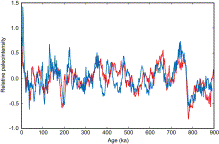An important part of being  a part of the palaeomagnetic community is keeping abreast of the current research. Here at Liverpool we hold fortnightly meetings to discuss recently published papers on a wide range of geomagnetism related subjects from the modern field to the deep past. Anyone can put forward a paper for discussion and whoever is most knowledgeable on the particular subject is invited to give a short review at the start of the meeting, this can be a great opportunity to get an insight into an area of geomagnetism you might not have any previous experience of and give a wider knowledge of the field. These are very informal and also act as a good excuse to all get together, drink tea and eat cake!
a part of the palaeomagnetic community is keeping abreast of the current research. Here at Liverpool we hold fortnightly meetings to discuss recently published papers on a wide range of geomagnetism related subjects from the modern field to the deep past. Anyone can put forward a paper for discussion and whoever is most knowledgeable on the particular subject is invited to give a short review at the start of the meeting, this can be a great opportunity to get an insight into an area of geomagnetism you might not have any previous experience of and give a wider knowledge of the field. These are very informal and also act as a good excuse to all get together, drink tea and eat cake!
As part of this blog we thought we’d give a brief summary of the papers we discuss.This week we looked at a review paper regarding relative palaeointensity and geochronology published in Quaternary Science Reviews.
http://people.rses.anu.edu.au/roberts_a/AR_Publications/152.%20Roberts%20et%20al.%202013.pdf
Andrew, P.R., Lisa, T. and David, H., Invited review: Magnetic paleointensity stratigraphy and high-resolution Quaternary geochronology: successes and future challenges. Quaternary Science Reviews.
This interesting review sets out the challenges faced by those using continuous high-resolution relative palaeointensity records to help constrain the chronology of sedimentary sequences, for example as an independent tool to synchronise different palaeoclimate records. It has been shown that magnetisations acquired in marine and lake sediments can faithfully record variations in the past geomagnetic field. This (post-) depositional remanent magnetisation is produced by detrital magnetic grains that align themselves to the Earth’s magnetic field as they settle through the water column or in the top ‘slushy’ part of the sediment water interface. A lack of understanding of the precise mechanisms involved does make it difficult to isolate a palaeointensity signal and perhaps more importantly assess its reliability. This paper looks into the current research on understanding magnetisation of sediments such as sediment type, diagenesis, flocculation and the effects of salinity and the influence of these on relative paleointensity records.
Despite not having a definitive theoretical understanding of how sediments record intensity there is compelling evidence to suggest they can be reliable. There is the global reproducibility of the stacks, the agreement with the production of cosmogenic radionuclides and the records of ocean crust magnetisation from deep-towed magnetometer surveys.
 Fig. 3. Comparison of predicted relative paleointensity from the magnetization inverted from a high-resolution marine magnetic anomaly stack (blue; data from Gee et al., 2000) and dipole moments from the PADM2M paleointensity stack (red; Ziegler et al., 2011). Ages for the magnetic anomaly record were rescaled to a common age for the Matuyama–Brunhes boundary (see discussion in the text concerning age offsets of some paleointensity features).
Fig. 3. Comparison of predicted relative paleointensity from the magnetization inverted from a high-resolution marine magnetic anomaly stack (blue; data from Gee et al., 2000) and dipole moments from the PADM2M paleointensity stack (red; Ziegler et al., 2011). Ages for the magnetic anomaly record were rescaled to a common age for the Matuyama–Brunhes boundary (see discussion in the text concerning age offsets of some paleointensity features).

Leave a Reply